
Home | Future Events | Previous Events | People | Articles | Reviews | AboutUs

Home |
Future Events |
Previous Events |
People |
Articles |
Reviews |
AboutUs
A New Interpretation of Natural Beauty and Sexual Selection
Lu, Chenguang
http://survivor99.com
Email: Survival99 at gmail.com
Abstract: Based on the concepts of need-based aesthetics, this article
attempts to answer two questions about natural beauty: 1) Why does so
much colour appear in nature (including colourful flowers, fruits,
and avian feathers)? 2) Why do people see beauty in natural environments
or mountain-and-river paintings that lack immediate utility?
To answer a question about sexual selection unresolved by Darwin
and Wallace, this paper gives examples of birds as evidence of how
the sense of beauty originates: showing how first needs such as food
influenced female tastes for beauty, and then the female tastes
selected for male’s appearances.
Key words: beauty sense, natural beauty, sexual selection, evolution, colourful birds
1. Introduction
Darwin left two questions unanswered in his famous work The Origin of Species [1]. The first is why flowers and fruits evolved with the colourful and well-flavoured forms we observe in nature. He thought that the preference of insects for certain colours and scents helped the formations of flowers: Fragrant flowers and well-flavoured pollen and nectar attracted more insects to transfer their pollen from one flower to another. Similarly, delicious fruits attracted more birds and beasts, who ate and spread them. However, where did the initial preferences of the animals come from?
The second is why many birds, such as peacocks, pheasants, mandarin ducks and wood ducks, have obvious tastes for beauty. Of course there are many birds with special colours that are advantageous for concealment or as signs for conveying information. However, this is insufficient to explain the cumbersome plumage of birds such as the peacock.
To explain why a peahen tends to select the best-looking peacock, Darwin proposed in The Descent of Man and Selection in Relation to Sex [2] that humans and birds base their selection of the opposite sex not only upon viability, but also upon beauty. However, Alfred Russel Wallace saw the principle of selection based on beauty as an unnecessary and contradictory supplement to the principle of natural selection. The British biologist Helena Cronin discussed a number of alternative explanations provided by later researchers, including the well-known arms race theory, in her book The Ant and the Peacock [3]. However, none of these explanations is satisfactory.
The author proposes needs-based aesthetics as the driver behind a sense of beauty; survival needs determine the taste for beauty [4]. The beauty sense drives an animal to approach and go after objects or environments that are useful to his or her survival. This paper explores the answers to the two questions outlined above and attempts to explain the cause of changes in human tastes for the beauty of natural environments.
2 The Origin of Colourful Nature
Natural science tells us that colours are representations of different parts of the electromagnetic spectrum. In fact, most electromagnetic waves are invisible to the eye.
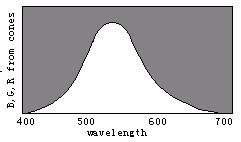
|
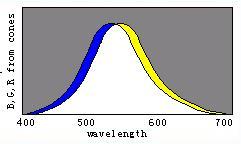
|
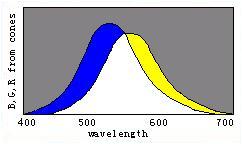
|
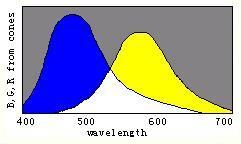
|
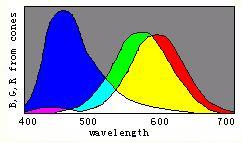
|
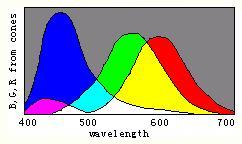
|
Fig.1 The human visible spectrum
Why is it that the visible part of the electromagnetic spectrum appears so often in nature? It is closely connected to the way that eyes evolved. Human eyes apparently enable us to discern seven, even more, distinct colours. However, these colour perceptions are only representations of the light reaching our eyes. Insects and fish see a different set of colours because they have different visual cells (cones). In addition, insects also see ultraviolet light; and fish see infrared light because their colour-sensitive cells have different characteristics.
Humans have three kinds of colour-sensitive cells. The number (M) of colours perceived increases with the number (N) of colour-sensitive cells. There are M = 2N where, for normal people, N = 3, M = 8 [5].
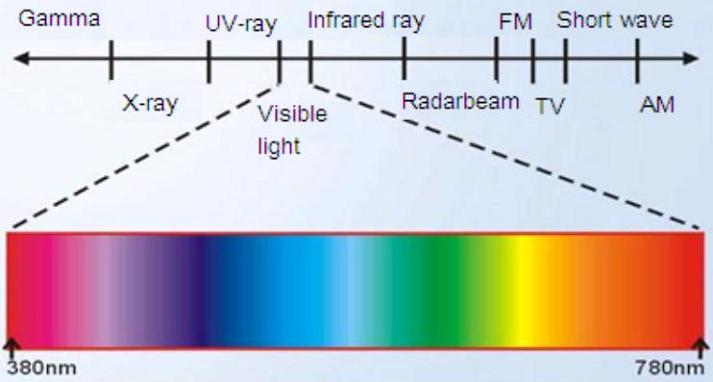 |
Fig. 2 Illustration of the evolution of human colour vision: the number of colours perceived increases with the number of colour-sensitive cells splitting from one to three kinds.
We may imagine that animals and plants exhibited only dull colours early in evolutionary history. Colourful flowers and fruits probably evolved only after animals and plants appeared on this planet and started evolving. Colourful flowers and fruits reflect light with certain wavelengths; while animals’ eyes evolved to discern those colours. What promoted the parallel evolution of flowers, fruits and animal eyes? It was the pressures of survival, needs relationships and the demand for conveying information.
Pollen and nectar provide nourishment to insects. Those flowers with more distinctive colours attract more insects; and more nutritious flowers attract more insects to pollinate them. Therefore, if a plant has flowers with distinctive colours (in other words, the flowers reflect light with different wavelengths) and is more nutritious, this plant is likely to have more descendants.
At the same time, if a certain type of insect has eyes that discern more colours, they are more likely to obtain nourishment with ease as they will be better able to distinguish between different fruits and flowers. Similarly, appreciating particular tastes of pollen and nectar and perceiving the fragrance and beauty of flowers, generates a motivation to seek out particular foods. Hence, natural selection would favour such insects. We may conclude that early in their evolutionary history, insects had preferences for certain flowers because of the nourishment they provided; the sense that they had an attractive fragrance or were beautiful evolved only after insects found they could get nourishment from them [4].
Similarly, the taste of birds and beasts evolved in parallel with the nourishment provided by certain fruits. More nutritious fruits are more likely to become food for animals. Their seeds are more likely to be spread and hence they are favoured by natural selection. At the same time, the birds and beasts are more likely to survive if they appreciate the taste of the fruits and are thus motivated to seek them.
This process may be described as a process of objectification.
3. The Secret of Avian Colourful Feathers
In 1987 the author of this paper argued that peahens found the peacocks’ plumage attractive because of its resemblance to berries they liked eating [6]. Recent work by the author shows that the colourful feathers of many birds imitate their preferred foods. For example, the males of several kinds of ducks have the shapes of spiral snails on their heads: the head of the male King Eider living in China looks similar to the spiral snail in China; while the head of the male Wood Duck in Northern America shares some characteristics with the spiral snail in Northern America. Similarly, the mandarin duck has a head with the shape of the clam and its yellow tail feathers imitate the body of the claim outside its shell (Figure 3).
The theory of needs-based aesthetics can explain this interesting finding. First the need for a particular food (e.g. spiral snails, clams) selected the duck’s taste for beauty – they evolved a sense of the beauty of that source of nourishment. This provided greater motivation to seek spiral snails or clams, which in turn increased their likelihood of survival. Then the same taste for beauty in the female duck selected the colour and texture of the feathers of the male, i.e. males with feathers that mimicked the spiral snails or clams were more successful at attracting females, and thus more likely to reproduce and their genes were selected.
 |
Fig. 3. Three kinds of ducks whose heads have the shapes of spiral snails and the mandarin duck whose wings have the shape of the clam. (top left: green head duck, top rith: king eider, bottom left: wood duck, bottom right: mandarin duck)
There are many other colourful birds whose feathers or appearances reflect their food needs. For example, the head of the rose-crowned fruit dove mimics fruit that the doves eat (Figure 4), the appearance of the crake show its taste for millet sprays (Figure 5), the plumage of pheasants mimics millet (Figure 5) and pine cones (Figure 6) and guinea fowl mimic the shape of corn (Figure 6) and the tragopan temminckii bears a resemblance to the grasshoppers it likes to eat (Figure 7).
 |
Fig. 4. The appearance of the Rose-crowned Fruit Dove shows a taste for the beauty of red fruits.
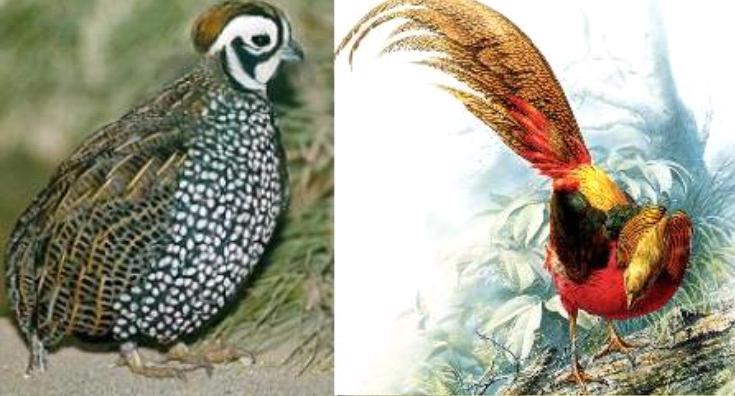 |
Fig 5. The appearances of the crake and the pheasant show their taste for millet sprays.
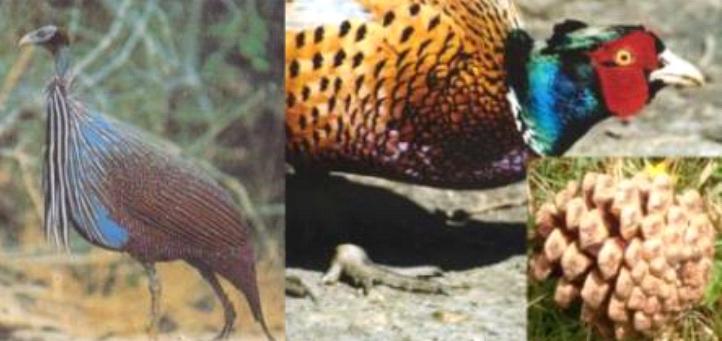 |
Fig. 6. The guinea fowl with the shape of corn on its body and pheasant with the shape of the pine corn on its body
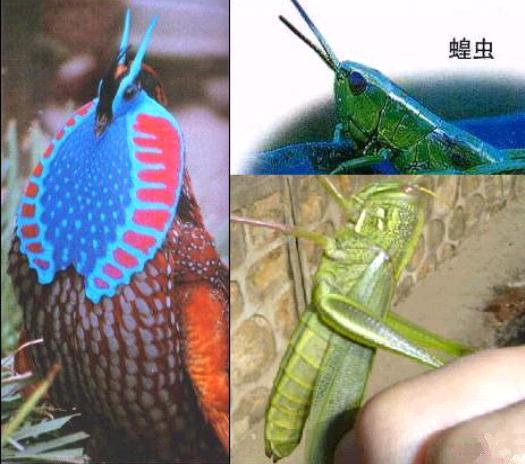 |
Fig. 7. The tragopan temminckii that likes to eat grasshoppers. [More]
Some birds also show a taste for the beauty of the environments they inhabit. For example, several kinds of migratory birds have male heads with island-like or lake-like shapes (Figure 8). It is important for them to find the appropriate environment while flying. What they like most is an island surrounded by a river or a lake surrounded by mountains where there are foods and safety. Their needs selected their taste for the beauty of environments, helping them to find the best habitats. The female taste for beauty later selected for male markings that reflected these preferences.
 |
Fig.8. The anas formosa or the face-colourful duck (left), which likes sand islands on rivers, has a face with a pattern that looks like a sand island in a river. The branta ruficollis (right), which likes to build nests on islands surrounded by river, also has a face that mimics the island and river pattern.
Note the close up of the face-colourful duck. There is white colour between “the green river” and “the yellow sand beach”, which precisely simulates the white water spray around the edge of an island [more details].
More examples can be seen on Chenguang Lu's website.
These examples provide some answers to the difficult question about sexual selection according to the needs-based aesthetics.
4. Evolution, Needs and the Significance of the Beauty Sense
The principle of needs-based aesthetics suggests that human tastes for fragrances, sweetness, and visual attractiveness are formed and determined by needs relationships. Human preferences evolve according to the rule that paths or means to an end become ends or final goals themselves. Human ends grow like branches of a tree [Figure 9]. The root is survival. Other ends are produced and developed following the rule of means becoming ends. Eating, drinking and love-making were simply means to survival at first. Later the means became ends in themselves – that is, enjoyment of these activities became ends. Other activities such as learning, dancing, fishing, and hunting were also initially paths or means which later became enjoyable and were transformed into forms of entertainment.
Pleasant sensations lead us to treat activities useful to survival as ends in themselves: Our pleasant gustatory sensations transform eating certain foods from paths into ends; and our pleasant visual and auditory sensations transform approaching certain objects from paths into ends.
In particular, our beauty sense encourages us to approach certain objects or environments, and transforming those actions from survival paths into ends.
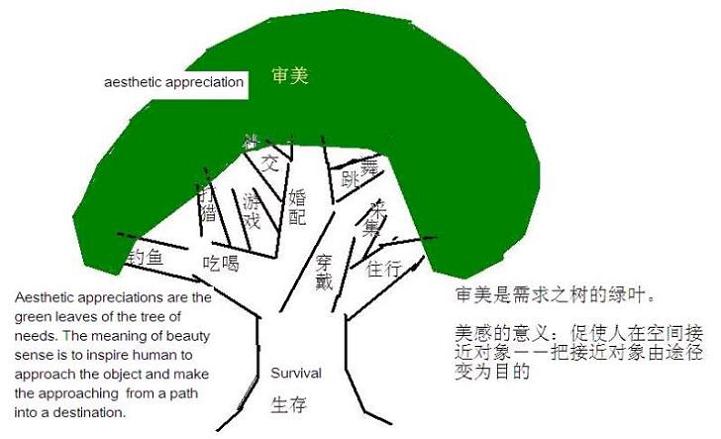 |
Fig. 9. The tree of the evolution of needs - the root is for survival, the leaves are the appreciation of beauty.
5. Changes in Human Tastes for Natural Beauty
Grosse studied the history of human painting and concluded that humans first paid attention to animals and plants for practical reasons and only later treated them as objects for beauty appreciation [7]. The earliest rock paintings show only animals without plants. Those paintings were mainly related to hunting, because at that time agriculture had not yet been invented. Plants became the aesthetic objects and entered the arts only after the advent of agriculture.
Although Grosse’s explanation is reasonable, he still failed to explain other facts. For example, with the growth of cities and the development of modern industry, paintings of mountains and water became more popular. In contrast machines and factories are not considered beautiful by many people despite their use value.
From the perspective of needs-based aesthetics, the beauty sense is created through a sense of dissatisfaction or lack of something. Human beings perceive the beauty of nature because they are sick of busy and crowded cities, and want to escape industrial pollution and return to idealised natural environments. Many people who live in rural areas do not see the scenery they live in as beautiful. Only after living in a big city for a long time do they began to yearn for the scenery and to find the beauty in the rural landscape. Grosses mentioned that people who live in a particular place do not generally consider the native flowers as beautiful. Perhaps after living in a desert for several years, they would gain an appreciation of the beauty of flowers.
In ancient China, mountain-and-water paintings were appreciated very much by the literati because of frequent wars and slaughters in the history. To the literati, the cost of living was not a problem, but the security of life was a real issue. The introduction to the well-known essay, “The Peach Blossom Spring" by Tao Yuanming helps to explain this type of appreciation: “The governors lived dissolutely, and struggled with each other. The warlords continuously fought. Heavy taxes and corvée sharpened exploitation and the grind of common people.” [http://zhidao.baidu.com/question/331331.html]
 |
Fig. 10. A mountain-and-water painting by Dong Yuan at the end of the Tang Dynasty - water is an essential resource for living, while the mountain is a refuge during wars.
6. Human Sexual Selection
Human beings select their spouse first for the sake of survival. That is, survival needs influence a person's preferences, and conversely those preferences reinforce beauty tastes.
For instance, when selecting a female, a man tends to first check for signs of her fertility and whether she is young and healthy. Then he looks at whether the woman is gentle. Sometimes, a working-class man also looks at whether the female is physically strong and is able to bring in some income. Rich families, on the other hand, possibly put more weight on the intelligence and virtues of the female.
When selecting a male, a woman tends to pay more attention to his survival ability, and cares about whether he is strong, wealthy and able to bring security to the family. Once the taste for beauty forms, it has relatively independent significance. It seems that human beings inherit the taste for beauty from generation to generation. Such taste becomes a summary of human sexual selection experience over many generations.
The sense of ugliness has the same characteristics in that it is also driven by human survival instincts. For instance, a person with apparently leprous symptoms will look ugly to all people including kids.
In addition, the understanding of human beings after birth also affects their sense of what is beautiful. The more a person thinks an object to be good and the more he likes it, the more the object looks beautiful to him or her. If an object is easy to approach, then the sense of beauty may not be that intensive. The reason for this is that the significance of the beauty sense is to drive the person to approach the object. Why do we need an image and certain distance to appreciate beauty? We won’t approach an object without an image of that object in our mind, and we won’t have enough motivation to pursue that object if it is at hand. This is also the reason why the lover’s eyes perceive beauty in the object of their desires. There are other situations in which for example, a woman looks pretty initially, but our rational knowledge tells us that she behaves improperly or has a seriously infectious disease, and her “beauty” may gradually disappear.
In brief, needs relationships for survival determines the beauty-appreciation in the mind of human beings of both sexes. Conversely, beauty-appreciation promotes the needs relationships.
7. Summary
This paper addresses a series of questions about natural beauty using the concept of needs-based aesthetics. It is argued that the pressures of survival, needs relationships and the demand for conveying information promoted the parallel evolution of flowers, fruits and animal eyes and sense of smell. A case study of a number of different birds is presented as evidence of the role need-based aesthetics plays in sexual selection, providing a new explanation of how a sense of beauty originates: first needs such as food influence tastes for beauty, and later the female’s tastes select for male’s appearances. However, for modern humans need-based aesthetics is driven by dissatisfactions with industrial society and city-living, resulting in a sense of the beauty of rural landscapes that is not found in nature or in people who live in rural settings. Turning to human sexual selection, a sociobiological approach is adopted in arguing that human tastes for beauty and related preferences for mating partners are driven by survival needs.
ACKNOWLEDGMENT
The author would like to thank Dr Caspar Hewett for his revisions and reorganization of this paper.
References
1. Charles Darwin, The Origin of Species (in Chinese), Science Press, 1972
2. Charles Darwin, The Descent of Man, and Selection in Relation to Sex (in Chinese), Science Press, 1982
3. Helena Cronin, The Ant and the Peacock: Altruism and Sexual Selection from Darwin to Today, Cambridge University Press, 1993
4. Chenguang Lu, “Mystery of beauty sense and evolution of needs” (in Chinese), Science and Technology University Press, 2003. (see: http://survivor99.com/lcg/english/ )
5. Chenguang Lu, “Mystery of colour vision and fundamental question in philosophy”, Science and Technology University Press, 2003
6. Chenguang Lu, “Trying to resolve the problem left by Darwin about fragrance ,sweetness and beauty --Extension of the principle of historical materialism to biology”, Information from Nature, No.2, 1987. (see:
http://survivor99.com/lcg/english/beauty/EEP3.html
)
7. Ernst Grosse, The beginnings of art, New York : D. Appleton and company , 1914
|
Related articles on this site Sex, Intention and Intelligence by Caspar Hewett
Darwinism without Darwinitis by
Raymond Tallis
Selfish genes, sex, and sanity by
Christopher Badcock Breathing fire into the equations of time and mind by Hugh Deasy Of Blank Slates and Zombies by Caspar Hewett Having Your Cake Before It’s Made: philosophical reflections on Steven Pinker’s biological view Of human nature by David Large Do we need a biological theory of human nature? by David Large From the Great Humpty Dumpty Disaster to the Emperor’s New Meme by Hugh Deasy The Great Debate: What does it mean to be human? proceeding of a discussion held at Newcastle Playhouse, May 2003 by Jon Bryan Mentalism and Mechanism the twin modes of human cognition by Christopher Badcock PhD Modern Theory and the Human Mind by Caspar Hewett What Can Science Tell Us About Human Nature? by Kenan Malik Sexual Selection: The Human Mind and the Peacock's Tale by Caspar Hewett The Great Debate: Darwinism Today by Caspar Hewett Minds, Genes and Consciousness by Caspar Hewett Minds, Genes and Consciousness: What Decides? by David Large Determinism and Free Will in Science and Philosophy by David Large Philosophical Responses to Evolution by David Large Genes, Experience and What Makes Us Human Gill Norman reviews a lecture given by Matt Ridley as part of Newcastle Science Festival 2003 The Great Blank Slate Debate Reflections on the Blank Slate Caspar Hewett reports on a talk by John Dupre at the Café Scientifique and on Steven Pinker in conversation with Matt Ridley, International Centre for Life. No One at Home - What's New? David Large reflects on the thoughts of Steven Pinker Someone's at Home - This is Good Nikolas Lloyd replies to David Large Of Course Someone’s At Home - Grandma, the Wolf and a Boojum by David Large: A reply to ‘Someone's at Home - This is Good’ by Nikolas Lloyd Nature versus Nurture, or Science versus Art? by Nikolas Lloyd: A Reply to ‘Of Course Someone’s At Home - Grandma, the Wolf and a Boojum' by David Large I Talk to the Genes (but they don’t listen to me) by David Large: Closing Remarks on 'Nature versus Nurture, or Science versus Art?' by Nikolas Lloyd |
Home | Future Events | Previous Events | People | Articles | Reviews | AboutUs
© C J M Hewett, 2010